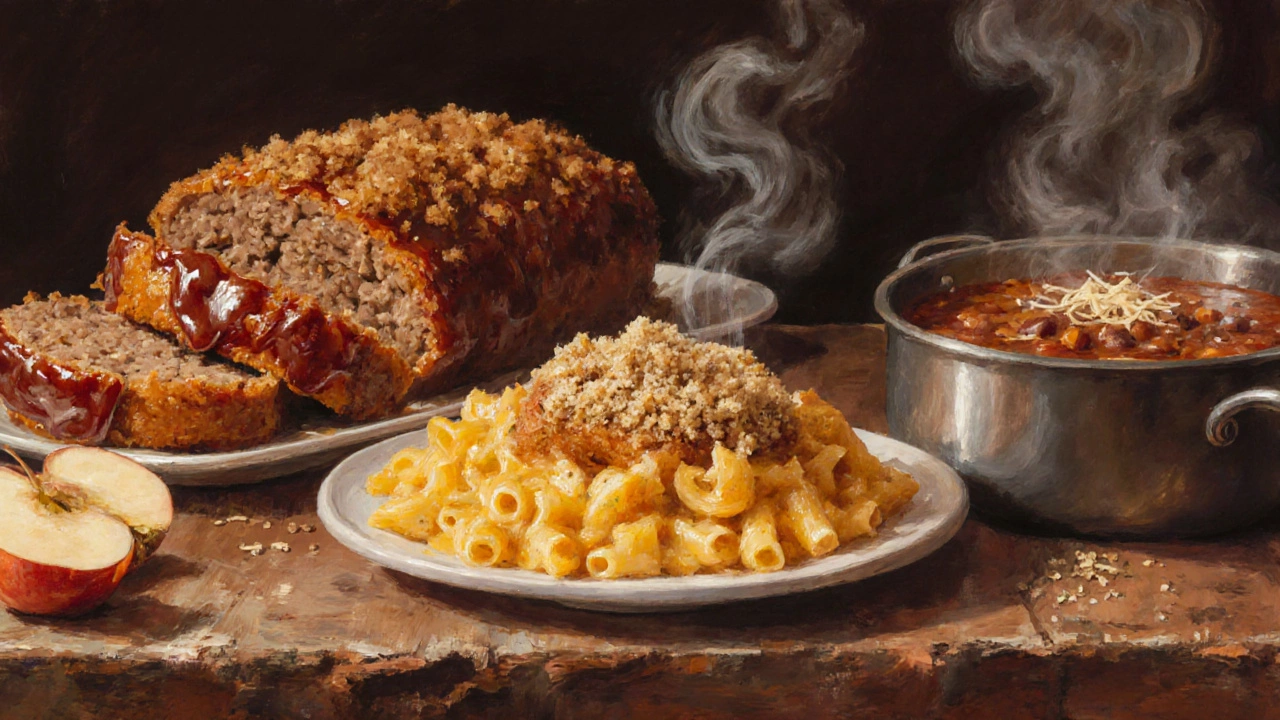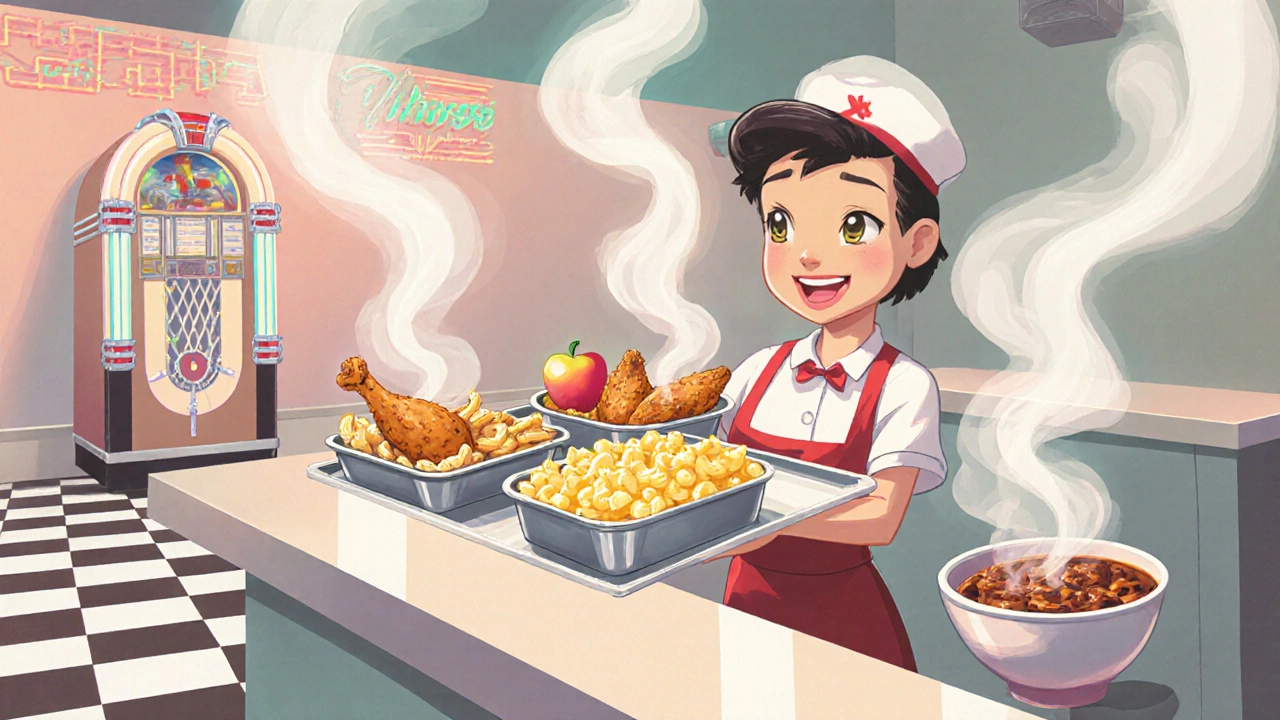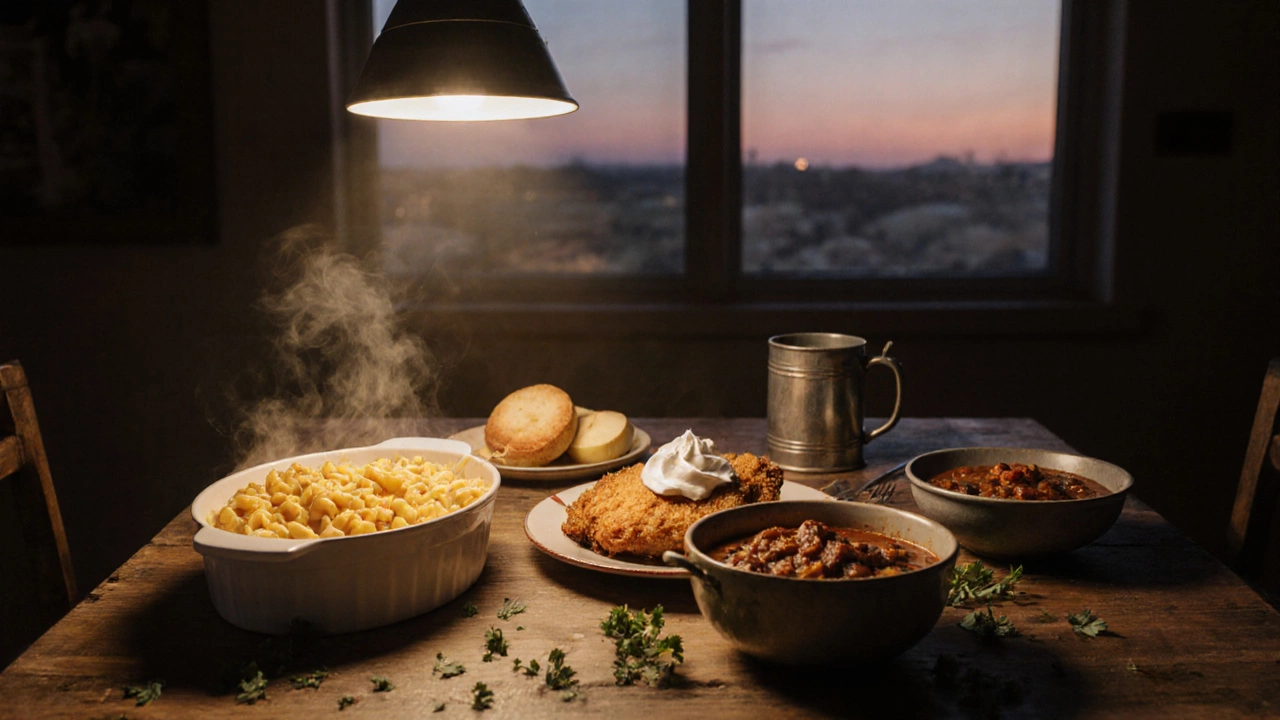When you think of American comfort food a collection of dishes that bring nostalgia, warmth, and a sense of home to diners across the United States, images of creamy macandcheese, crispy fried chicken, and a slice of steaming apple pie probably pop up instantly. Those foods have earned a spot at family tables, holiday gatherings, and late‑night diners because they deliver more than flavor-they deliver memory.
American comfort food isn’t just a menu category; it’s a cultural touchstone that ties generations together. Below we’ll unpack what makes a dish qualify as comfort food, trace the history of the most beloved classics, and give you a practical cheat‑sheet for cooking them at home.
What Turns a Dish Into Comfort Food?
Comfort food usually checks three boxes:
- Familiarity: The recipe is often handed down through families or popularized by regional eateries.
- Texture & Flavor: Rich, creamy, salty, or sweet elements that trigger happy brain chemicals.
- Emotional Association: Links to holidays, childhood, or “just‑right” moments when the world felt safe.
Because these criteria are subjective, the list varies by region and personal history. Still, certain dishes have risen to national fame by consistently hitting all three notes.
A Brief History of America’s Comfort Food
Early settlers relied on hearty stews and breads to survive harsh winters. As railroads and refrigeration expanded in the late 19th century, regional specialties-like New England clam chowder or Southern fried chicken-found their way onto broader tables. Post‑World WarII prosperity introduced convenience products, turning boxed macaroni‑and‑cheese and canned soups into pantry staples. By the 1970s, the term “comfort food” entered popular lexicon, anchored by TV chefs who showcased home‑style cooking for a nation craving stability.
Iconic American Comfort Dishes
The following dishes represent the backbone of comfort cuisine in the United States. Each entry includes a short history, core ingredients, and a tip for elevating the home version.
Macandcheese a baked or stovetop blend of pasta, cheese sauce, and sometimes breadcrumb topping emerged in the 1930s when processed cheese became affordable. The secret to a velvety sauce is to melt cheese slowly over low heat and finish with a splash of cream. For extra depth, stir in a pinch of smoked paprika or a handful of caramelized onions.
Fried chicken crispy, seasoned chicken pieces cooked in hot oil until golden traces its roots to Southern African‑American cooks who perfected a double‑dip coating of flour and buttermilk. Brining the chicken in a salty solution for at least three hours guarantees juicy meat, while a hot oil temperature of 350°F ensures the crust stays crunchy.
Meatloaf ground meat mixed with binders, seasoning, and sometimes vegetables, baked as a loaf became popular during the Great Depression as a way to stretch inexpensive beef. Mix half beef, half pork for flavor balance, and glaze with ketchup mixed with brown sugar for a sweet‑savory finish.
Apple pie a double‑crusted pastry filled with spiced apples, often served warm earned the nickname “American as apple pie” after WorldII, when soldiers brought the dessert back home. Use a blend of Granny Smith and Honeycrisp apples for tartness and sweetness, and add a splash of bourbon for an adult twist.
Chili a simmered stew of meat, beans, tomatoes, and chili peppers evolved in Texas border towns during the late 1800s, where cattle workers needed a one‑pot meal. Skip the beans if you prefer the “Texas‑style” version, and slow‑cook the meat with smoked paprika for a deep, smoky note.
Biscuits and gravy flaky baked biscuits smothered in a sausage‑based brown gravy started as a breakfast staple in the American South. For lighter gravy, use a mixture of turkey sausage and skim milk, but keep the peppery kick that defines the dish.
Other beloved entries include New England clam chowder, loaded baked potatoes, and the ever‑satisfying chicken‑and‑dumplings-each carrying its own regional story and comforting texture.

Side‑by‑Side Comparison of the Top Five Classics
| Dish | Main Ingredient | Typical Region | Prep & Cook Time | Comfort Rating* (1‑5) |
|---|---|---|---|---|
| Macandcheese | Elbow pasta + cheddar | Nationwide | 20min | 5 |
| Fried chicken | Chicken thighs | Southern US | 45min | 5 |
| Meatloaf | Ground beef & pork | Midwest | 1hr | 4 |
| Apple pie | Apples | Nationwide | 1.5hr | 5 |
| Chili | Ground beef | Texas | 2hr (slow simmer) | 4 |
*Comfort Rating reflects how often the dish appears in family celebrations and how strongly people associate it with “home.”
How to Recreate Classic Comfort Dishes at Home
Every comfort dish shares a few practical principles that make cooking easier and tastier:
- Prep in advance. Many recipes improve after a short rest (e.g., chili tastes better next day).
- Use quality base ingredients. Fresh, locally sourced produce and dairy elevate the final flavor.
- Don’t over‑cook. Over‑baking macandcheese dries the pasta; keep an eye on the timer.
- Season layer by layer. Add a pinch of salt after each major step to build depth.
- Finish with texture. A breadcrumb topping, crisped bacon bits, or a drizzle of honey adds the finishing “comfort” crunch.
Here’s a quick cheat‑sheet for three beginner‑friendly recipes:
- Macandcheese: Cook pasta 1minute less than package calls for, whisk flour, butter, milk, and shredded sharp cheddar into a roux, then combine and bake with panko topping at 375°F for 15min.
- Fried chicken: Brine chicken pieces 4hours, dip in seasoned flour, then a buttermilk bath, back to flour. Fry 8min per side, keep oil at 350°F.
- Chili: Brown ground beef with onion, add canned tomatoes, beans, chili powder, cumin, and smoked paprika. Simmer 90min, stir occasionally.

Common Pitfalls & How to Avoid Them
Even seasoned cooks stumble over a few traps when tackling comfort classics:
- Dry pasta in macandcheese. Reserve the pasta cooking water and stir a few tablespoons into the sauce for silkiness.
- Soggy fried chicken crust. Pat the chicken dry before breading, and use a thermometer to maintain oil temperature.
- Flat‑tasting meatloaf. Mix a splash of Worcestershire sauce and a spoonful of ketchup into the meat blend before baking.
Key Takeaways
- Comfort food blends familiar flavors, comforting textures, and emotional connections.
- Macandcheese, fried chicken, meatloaf, apple pie, and chili dominate the American comfort scene.
- Quality ingredients, proper seasoning, and a little patience make home versions rival restaurant classics.
- Use the comparison table to pick a dish that fits your time, skill level, and regional cravings.
- Avoid common mistakes by managing moisture, temperature, and seasoning at each stage.
Frequently Asked Questions
What makes a dish a "comfort food"?
A comfort food typically feels familiar, delivers rich or soothing flavors, and is linked to happy memories or specific occasions. The combination of texture, taste, and emotional resonance creates that cozy feeling.
Which American comfort food is quickest to prepare?
Macandcheese is often the fastest-cook the pasta, whisk a quick cheese sauce, and bake for just 15minutes. You can even skip the bake step for a stovetop version ready in 20minutes total.
Can I make these dishes healthier without losing comfort?
Yes. Swap heavy cream for low‑fat milk in macandcheese, use skin‑on chicken thighs baked instead of deep‑fried, and choose lean ground turkey for chili. Adding extra vegetables (like spinach in meatloaf) boosts nutrition while keeping the comforting feel.
Why is apple pie called "American" when it originated in Europe?
Apple pie arrived with early European settlers, but after WorldII it became a national symbol through marketing and cultural references. Its ubiquity at Fourth of July celebrations cemented the myth that it’s uniquely American.
Do regional variations matter for comfort food?
Absolutely. A New England clam chowder, a Southern hush‑puppy, or a Midwestern casserole each reflects local ingredients and traditions, and those nuances shape how people experience comfort.

